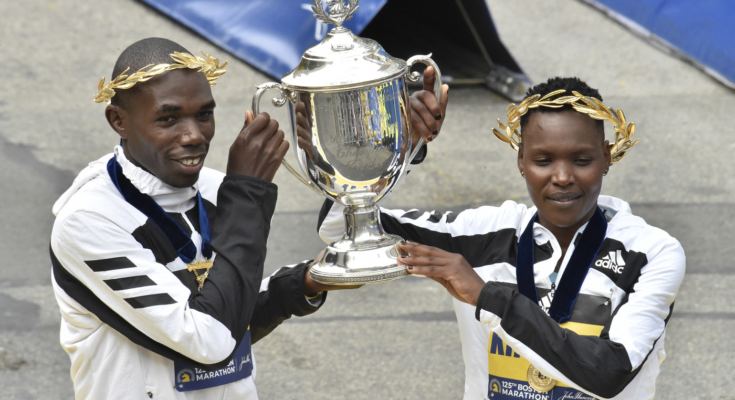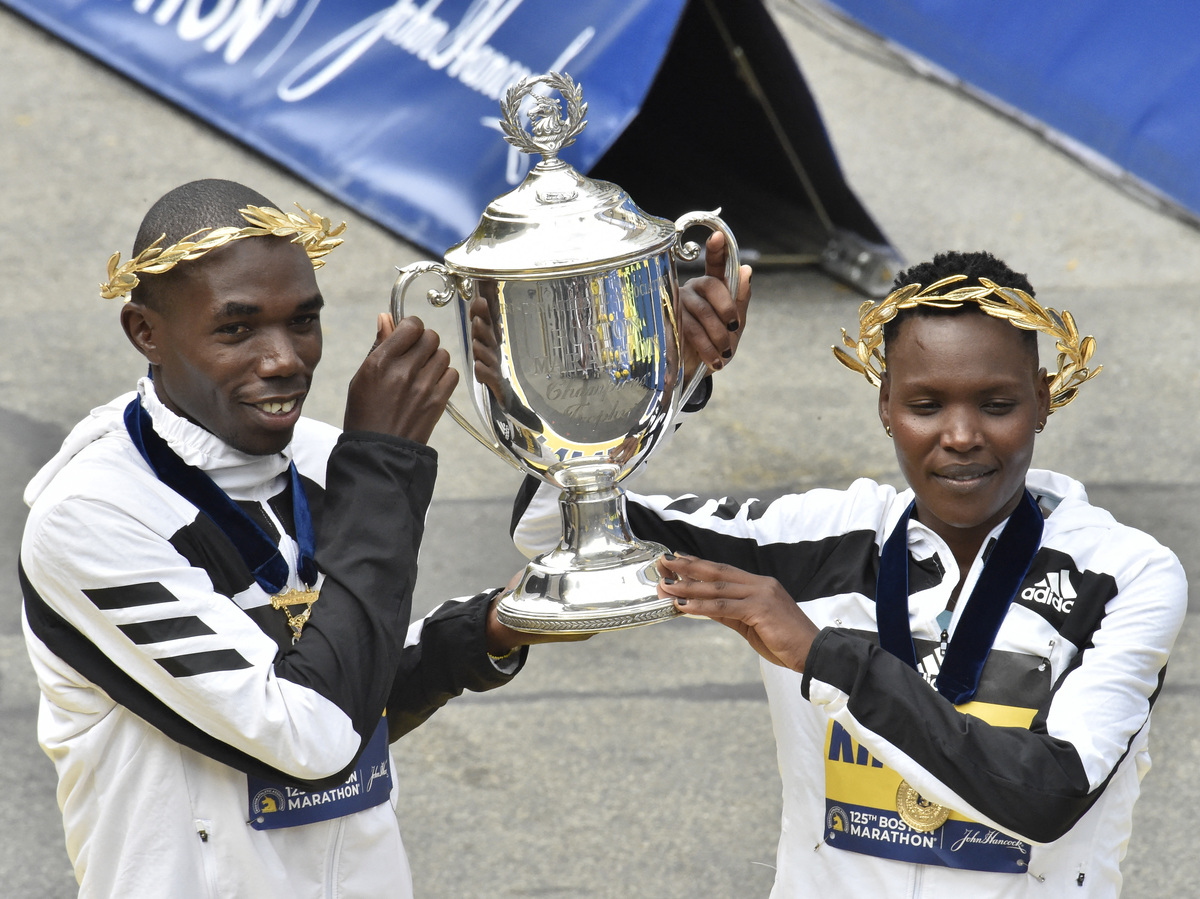
Benson Kipruto (L) and Diana Kipyogei (R) of Kenya hold up the victory trophy after taking first place in the professional men’s and women’s divisions during the 125th Boston Marathon in Boston, Massachusetts on Monday. The first Boston Marathon since April 2019 strayed from tradition in several ways.
Joseph Prezioso/AFP via Getty Images
hide caption
toggle caption
Joseph Prezioso/AFP via Getty Images
Benson Kipruto (L) and Diana Kipyogei (R) of Kenya hold up the victory trophy after taking first place in the professional men’s and women’s divisions during the 125th Boston Marathon in Boston, Massachusetts on Monday. The first Boston Marathon since April 2019 strayed from tradition in several ways.
Joseph Prezioso/AFP via Getty Images
The 125th Boston Marathon was two-and-a-half years in the making. Its champions, however, needed just over two hours to cross the finish line.
Kenyan runners Benson Kipruto and Diana Chemtai Kipyogei won the men’s and women’s fields, respectively. Kipruto clocked in at 2:09:51 and Kipyogei at 2:24:45, clinching the eighth Kenyan sweep since 2000.
Two Swiss athletes won the men and women’s wheelchair division. Marcel Hug won his fifth event — after taking a wrong turn and missing his personal best by seconds — at 1:18:11. Manuela Schar sustained an early lead to finish at 1:35:21 and claim victory for a third time.
This was the first in-person Boston Marathon since April 2019. It’s also the first time in more than a century that the race has not been held in the spring — and, notably, falls on Boston’s first officially recognized Indigenous Peoples’ Day.
How they won
Kipruto reportedly started Monday’s race with the third-fastest personal best among the contenders, but did not spend the whole race at the head of the pack.
American CJ Albertson was leading at the halfway point, the AP reports, before Kipruto surged ahead and created a sizable gap. He maintained that lead and finished 46 seconds ahead of the second-place runner. (Albertson, the American, ultimately finished 10th.)
Kipyogei’s victory marks the first time she has won one of the so-called World Marathon Majors. She crossed the finish line 23 seconds ahead of Edna Kiplagat, the 41-year-old Kenyan who won in 2017.
Hug won his fifth Boston Marathon wheelchair race despite missing the second-to-last turn and having to backtrack to get on course.
The Switzerland native, who competed in the Chicago Marathon on Sunday, said he mistakenly followed the lead vehicle.
He finished just seven seconds short of his course record, but the wrong turn carried a steep price tag: a $50,000 course record bonus.
Schar maintained an early lead to win the women’s wheelchair race, as she did in 2019 and 2017 — when she set a course record. She placed ahead of American Tatyana McFadden, who won the Chicago Marathon on Sunday.
Notably, COVID-19 postponements mean that five major international marathons are taking place within 42 days of each other, with Chicago and Boston one day apart. Here’s how some of the world’s best wheelchair racers prepared for the challenge.
Returning after pandemic disruptions
The fall foliage wasn’t the only sign that Monday’s marathon broke from tradition.
Because of the pandemic, organizers postponed, then canceled, last year’s event for the first time since 1897. The marathon went virtual, with runners required to complete the 26.2 miles in six continuous hours or less during a week in September and show proof of timing.
The Boston Athletic Association then delayed the date of the 2021 marathon in order to comply with Massachusetts’ COVID-19 reopening framework, announcing earlier this year that it would take place in October.
Organizers say they took plenty of precautions, including reducing the field size by 36% compared to previous years and introducing a rolling start in order to facilitate social distancing.
All participants were required to provide proof of a WHO-recognized vaccination or negative COVID-19 test, and organizers say 95% of all volunteers (including 100% of medical volunteers) are vaccinated. Masks were required indoors, on event transportation and within the starting area.
A virtual marathon also took place from Friday to Sunday, and featured nearly 30,000 athletes competing from home around the world. Organizers say the combined in-person and virtual races made up the largest Boston Marathon in history.

Runners make their way to the finish line down Boylston Street during the 125th Boston Marathon in Boston, Massachusetts on Monday. It’s the first time the event has been held in the fall in more than a century.
Joseph Prezioso/AFP via Getty Images
hide caption
toggle caption
Joseph Prezioso/AFP via Getty Images
Runners make their way to the finish line down Boylston Street during the 125th Boston Marathon in Boston, Massachusetts on Monday. It’s the first time the event has been held in the fall in more than a century.
Joseph Prezioso/AFP via Getty Images
Honoring Indigenous Peoples’ Day
This year’s historic race also falls on Indigenous Peoples’ Day, which the city of Boston is celebrating officially for the first time.
Some advocates expressed fears that the marathon would overshadow the holiday, which aims to honor Indigenous communities.
(Indigenous Peoples’ Day Newton Committee members Chali’Naru Dones and Darlene Flores spoke to member station WBUR about the conflict and their work.)
The Boston Athletic Association said in August that it did not intend to take away from Indigenous Peoples’ Day in selecting the marathon date, and extended its “sincere apologies to all Indigenous people who have felt unheard or feared the importance of Indigenous Peoples’ Day would be erased.”
Organizers said they met with tribal representatives to consult on ways to honor the Indigenous community.
Those steps included a ceremony before the marathon to acknowledge that the race travels through Indigenous homelands and donating to the Indigenous Peoples’ Day Newton Committee to help fund their first-ever Indigenous Peoples’ Day Celebration.
Organizers are also celebrating Indigenous runners in banners across Boston.
They honor Ellison Brown (Narragansett), who won the 1936 and 1939 races, three-time runner-up Patti Catalano Dillon (Mi’kmaq) and other names from history including 1907 champion Tom Longboat.
Secretary of the Interior Deb Haaland — a member of New Mexico’s Pueblo of Laguna and the first Native American Cabinet secretary in U.S. history — was one of the day’s participating runners.
She wrote about the significance of the date in a column published in The Boston Globe, in which she honored the Indigenous runners who came before her — from those celebrated marathon winners to the ordinary villagers who used running to keep their communities and cultures alive.
“Indigenous Peoples’ Day is also a day when we remember the sacrifices of our ancestors and their survival during the dark eras of colonization and assimilation — eras in which Native Americans suffered atrocities that manifest themselves in health disparities, lack of basic infrastructure, the missing and murdered Indigenous peoples’ crisis, and so much more,” she wrote. “On this special day, I will run for missing and murdered Indigenous peoples and their families, the victims of Indian boarding schools, and the promise that our voices are being heard and will have a part in an equitable and just future in this new era.”







